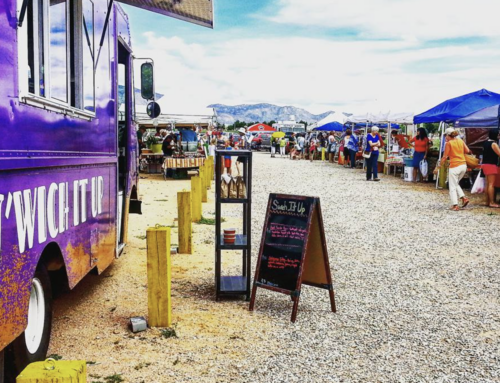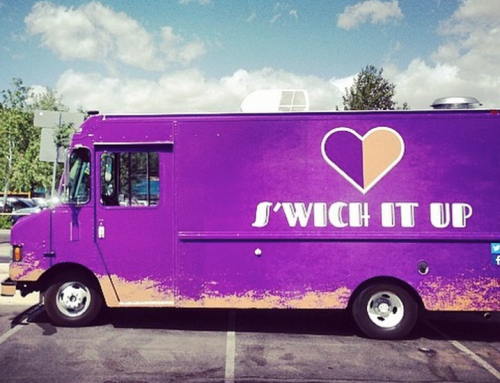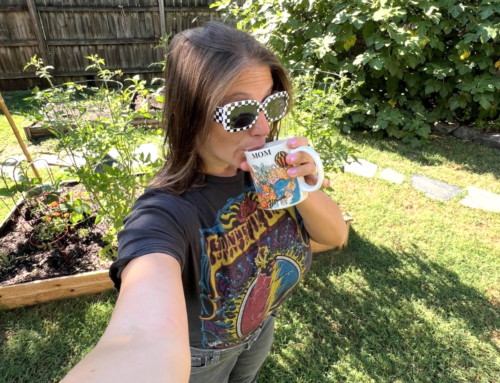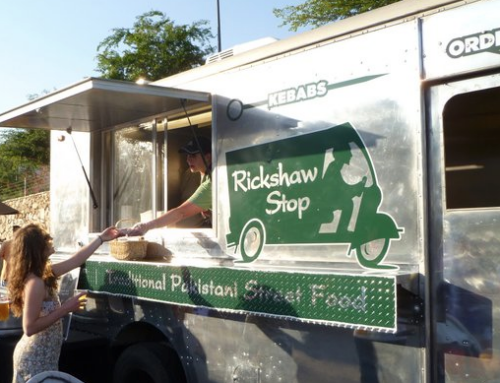Podcast: Play in new window | Download | Embed
Subscribe: RSS
Thinking about starting a burger restaurant or truck? We conduct a deep dive into the $100+ billion dollar burger restaurant industry in the United States, the estimated costs to get started, and profit potential for this massive food business opportunity. The companion podcast for this market analysis is brought to you by our sponsor Gusto.
Burger Industry Analysis Outline:
Introduction
In the United States, our appetite for cheeseburgers is showing no sign of slowing down. Whether you prefer more fanciful creations made with custom grinds of beef and topped with seared foie gras and pickled bing cherries, or more humble sackfuls of grease-soaked sliders, there’s a new independent hamburger restaurant to suit your cravings popping up every day nationwide, making the burger industry is valued at nearly $100 billion dollar per year. And it’s easy to see why; culturally, burgers are the great equalizer, enjoyed by almost everyone across geographic and economic lines.
Burgers are, to my way of thinking, basically a perfect food, almost diabolically designed to ping all of the pleasure centers of your brain. When confronted with a big hit of protein and carbohydrate, along with heaping helpings of sugar, fat, and salt, most of us are nearly powerless to resist…which is what makes burgers a safe bet for any aspiring food business entrepreneur.
Burgers are also recession-proof; in economic boom times, consumers celebrate with a burger and a beer, and when the economy slows, burgers provide customers an inexpensive way to enjoy a meal outside of the house. In some areas, burgers are even proving themselves to be pandemic-proof; many sit down burger restaurants have managed to transition neatly from sit-down table service to curbside or delivery options, thanks to the ability of burgers to travel reasonably well. A photo of two of my “burger night” burgers are below.

Two burgers with brioche sesame seed buns.
Adding a once-weekly “Burger Night” to our operations at Ancho Honey, my grab-and-go restaurant in coastal Maine, has been positively transformative for our business, and today, we’re going to talk about why that is, and how you can replicate that success in your own business.
Burgers Don’t Scare Anybody
One of the main reasons I’ve come to fully embrace the burger-centric part of our business is simple: Burgers don’t scare anybody. As a cook, I’m constantly brainstorming new ideas for new dishes, combining flavors in funky ways that, if presented on a plate, might seem challenging or off-putting to some customers. I can pile those same elements on a burger, however, and instantly have customers understand both what they’re eating, and what I’m trying to do.
Related Reading: How I Opened a Restaurant with No Money and a 540 Credit Score
A $28 entrée festooned with piles of unusual vegetables, drizzled with elaborate sauces, and artfully splashed with compotes may alienate some customers; arrange them on a quarter pound of seared ground beef, however, and those same customers are instantly familiar with what you’re trying to do, and may even appreciate it more. Using burgers as a sort of pallet allows us, as cooks, to be experimental, without having to worry that we’re going to scare off customers.
Options for creativity with burgers
I find a lot of reassurance in the fact that there are a certain set of “rules” when it comes to constructing a new burger idea; a burger has to, at its most basic, contain a stack of meat, cheese, bread, and usually some type of vegetable topping and sauce. This confines you to a set of rules make it much easier to create new ideas, because really, you’re just plugging new ingredients into a defined set of columns.

Burger with mushrooms.
I believe that a good burger contains the following elements: A seared protein, to provide salty heft and char. Some kind of cheese, for fatty ooze. Something crunchy. Something acidic. Sometimes, something spicy. And something sweet. Let’s think of it this way:
Meat + cheese + crunchy + acidic or spicy + sweet.
Combine all or most of those elements into one burger, and you’ll almost always come up with something amazing. And the options for what you can plug into those main categories are almost limitless.
For example, using the formula above gets us:
- Beef burger + sharp cheddar + arugula +pickled red onions
- Lamb burger + feta + shredded cabbage + tzatziki
- Chicken burger + blue cheese + shredded romaine + wing sauce + sweet pickles
Once you have this formula in place, and are thinking of new ways to get all of those contrasting elements in play, the options for burger creativity become basically limitless.
Sometimes, I’ll also use some sort of “metaphor” for creating a new burger, or in other words, taking some other real-world food item, and figuring out how to translate it to burger form. Here in New England, I’d been stuck thinking about a traditional dish we serve called a “boiled dinner.” The name is almost as uninspiring as the dish itself: A pot filled with corned beef, potatoes, cabbage, and turnips, boiled to oblivion and served to kids in Maine at least once a month, all winter long.
Still…even though the original dish isn’t super inspiring, there’s something about that combination of flavors that triggers nostalgia in some locals, so I wanted to translate each of those elements to burger form. Our “Boiled Dinner Burger” combined a third pound of seared ground beef, and then plugged in the rest of the formula to figure out the rest: swiss cheese (melt!), crunchy cabbage slaw (crunch!), fried potato sticks (crunch!), shredded corned beef (salt!), and a drizzle of Guinness mustard aioli (acid!).
It was a big hit.
You can use this same structure to convert almost any real-world dish into burger form, which opens entirely new pathways to creativity, and will get your customers buzzing about your product like never before.
Burgers are Instagram Food
When it comes to marketing your business on social media, it doesn’t get much easier or more effective than featuring gorgeous photos of big, messy, drippy burgers; social media users love them, and you’ll find your “likes” and shares tend to be much higher, when posting this type of content.
That’s why the Ancho Honey Instagram feed has been, for the last year or so, almost 80% pictures of our latest burger specials; they get clicks, they generate interest, and they get shared more than any other type of content we post. Build your business around burgers, add in some basic food photography skills, and your social media marketing efforts practically take care of themselves.
The Economics of Burgers

Total burger cost breakdown.
From a pure dollars-and-cents perspective, burgers continue to make good sense. But choosing where to invest in your burgers, and where to save, is an important part of figuring out how to build your burger business.
Here’s the cost breakdown of a burger at our restaurant:
- Burger patty: $1.30
- Seeded Brioche Bun: $0.68
- 2 Slices of American Cheese: $0.22
- Caramelized onion, lettuce, tomato, burger sauce: $0.50 (approx.)
Total Cost Per Burger: $2.70
According to consumer surveys, the quality of the beef used at a burger restaurant is the top consideration among customers; the array of toppings available are a close second. This means, that, for most businesses, you’ll have to decide where you want to place your focus.
Do you want to buy your own slabs of chuck and short rib, and fresh-grind your beef every day to your own custom proportions of fat and lean, making the quality of your beef your signature? Or do you want to offer a dizzying array of topping combinations, allowing customers to customize to their hearts’ content?
Related Reading: Cooking is My Passion. Should I Start a Restaurant?
The reality is, unless you plan to have your burger cost $24 dollars (and some places definitely do!), you probably won’t be able to do both. The decision on where to place your focus probably has a lot to do with where you live, who your customers are, and what kinds of competition exist in the marketplace.
When I first started in this business, I bought the best of everything. Heritage-breed pork from a local butcher. Custom baked bread loaves from my favorite bakery. Artisinal cheeses from a local cheesemonger. And yes, the food was incredible. However, the price at which I had to sell that food was, at least for the area I live, prohibitive.

Introducing the Ancho Double.
It took some time to figure out how to balance that sweet spot, between quality and cost, because believe it or not, some of the high cost of your ingredients doesn’t translate into value in the minds of most customers. I quickly figured out where to skimp, and where to splash out, in terms of my budget. Since pork tends to all taste the same after 12 hours in a smoker, I began buying pork from a national distributor.
I couldn’t taste the difference, and neither could my customers. Instead, I chose to keep spending money where customers could “see” it, in toppings like cheese and foundations like bread. Those things, they could understand, and pay more for…the pork, not so much. This way, I was able to drop my price to a level customers were happy with, while not really sacrificing the quality of my product.
Whether you decide to pour your money into your beef blend, or into an array of toppings that are totally bonkers and will get people talking, it’s probably a decision to make early on. While both approaches are completely valid and bring their own types of success, figuring out early where to spend, and where to save, will guide much of your decision making down the road.
How We Do Things at Ancho Honey
The evolution of our Burger Night at Ancho Honey has been nothing short of remarkable. What began as a gimmicky plan to generate a little extra weekly revenue during our off-season, has rapidly evolved into the biggest moneymaker of our entire week. Let’s talk a little bit about each element of our $6.95 house burger, the “AnchoBurger,” to see how it evolved over time in terms of preparation and cost.
The Burger
We decided early on that custom beef blends were not for us, and that instead, we wanted to do a volume-based business, where we were able to offer our burger inexpensively, and create hordes of customer traffic. On our most recent Burger Night, we sold 134 burgers in about three hours; that’s one burger every 80 seconds. When we first launched our Burger Night, however, things were much slower; a “successful” night meant producing more like 20 burgers.
Back then, we bought plain-old 80/20 ground beef from our distributor, pressed it thin by hand, and counted on a perfect sear on the flat top and a custom seasoning blend to give our burgers their character. While this allowed us to spend less on ingredients, as traffic grew, the labor costs became prohibitive.
Related Reading: 11 Best (No Cost) Restaurant Marketing Ideas
During what I think of as the “transition” period, where sales were strong but volume hadn’t yet gone totally crazy, my staff and I would spend 2-3 hours in the afternoon pressing out burger patties by hand. This quickly became unreasonable; whole portions of the day were being lost to basic burger prep, and I had to find a pre-formed solution.
After trying several different products, I finally found a third-pound burger patty that arrives fresh (never frozen), with a shape that doesn’t look too machine made, and most importantly to me, a diameter that perfectly matches our bun.
Because they arrive fully formed and ready to cook, I’m paying a bit higher price than I would for bulk ground beef, but the time and labor savings make it worth it. Through my distributor, I pay $52 for a 40-count case, or about $1.30 per burger.
The Bun
Look, buns are important to me. Perhaps overly so. But I think a good bun is what separates a good burger form a bad one. Finding a bun that will stand up to the onslaught of toppings I put on it without getting soggy or falling apart, was a bit of a challenge.
I also wanted a bun that would look great on Instagram, as well as trigger a sort of idealized, nostalgic fast food aesthetic in the minds of my customers. I finally settled on a seeded brioche bun, which costs $33 for a case of 48, or around 68 cents per bun.
The Toppings
Our burger is topped simply with two slices of American cheese, caramelized onions, chopped lettuce, a slice of tomato, and a house burger sauce that we make from scratch. The biggest cost factor here is the cheese; I pay $19 for 160 slices, or about 11 cents per slice, or 22 cents per burger.
When we first started, I was buying frozen and pre-cooked caramelized onions, but not only were they expensive (relative to, y’know, an onion), but I was running out of them constantly, and they proved easier to prep ourselves. Between the onions, lettuce, tomato, and burger sauce, let’s assume we’re adding another 50 cents to the cost of each burger.
The Pricing
If you’ve been following along with the math as you’ve been reading, you’ve probably noticed that every house AnchoBurger we sell costs us about $2.70 cents, which means that according to the standard pricing model for restaurants, we should be selling it for around $8. And believe me, plenty of other industry folks in my area have told me that, relative to the quality, $6.95 is an absolute bargain for the burgers we are producing. But I keep them priced low for a few reasons.
First, it gets people in the door, and since our business is in its infancy, there’s a certain marketing benefit to letting people know about the quality of our food. Second, where I live, unfortunately, we have two main competitors in the burger business: Fast food places, and crummy bars. The fast food places sell their burger for a buck, and they’re not very good.
Related Reading: 201 Burger Slogans and Caption Ideas Perfect for Social Media Marketing
The bars sell their burger for $15 bucks, and they’re also not very good. I wanted to hit a sweet spot that’s more competitive with a fast food place’s pricing, but with quality that blows theirs away; similarly, my pricing seems like a bargain compared to the bars and restaurants in town, who are serving burgers that are, quite simply, not as good.
Could I charge an extra dollar per burger, and make an extra $100 a night? Probably. Would it create as much buzz and excitement, and feel like an “event” that will draw customers in for some of my higher-margin items? Probably not.
How Ancho Honey’s Future Will (Probably) Be Built on Burgers
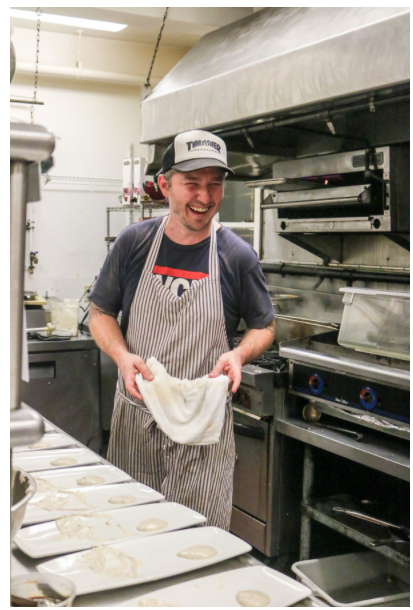
More burgers in this guys future.
At our restaurant, we’re at a bit of a crossroads, with a lot of different options available for moving forward. Our Burger Nights have transformed our business, quadrupling both the number of customers we serve each week, as well as our sales (even on our non-burger selling days).
The next logical step would seem to be throwing more of our efforts into our cheeseburgers, overhauling the menu to be more burger-focused, and making them always available.
But I have reservations about this: Making burgers a part of our regular menu would mean a significant investment in new kitchen equipment, including a bigger griddle and an upgraded exhaust system.
I also wonder if part of the success of Burger Night isn’t due in part to the artificial scarcity of our offering; if burgers were available anytime, would the ravenous demand for them be as high?
These are the right kinds of problems to have, however, and the right questions to be asking. Growing our burger business will likely be a big part of Ancho Honey’s growth over the next year, and whether you choose to start slinging them one night a week, or build an entire business around them, cheeseburgers could be the key to your business’ success, as well.
If you would like to get more long-form deep dives into different industries like this sign up for our free food business community with more than 45,000+ active subscribers.

